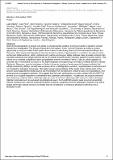Por favor, use este identificador para citar o enlazar a este item:
http://hdl.handle.net/10261/225396COMPARTIR / EXPORTAR:
 SHARE
BASE SHARE
BASE
|
|
| Visualizar otros formatos: MARC | Dublin Core | RDF | ORE | MODS | METS | DIDL | DATACITE | |

| Título: | Source to Sink Upstream or Downstream Propagation of Climate Cycles and Events: Insights from the South Pyrenean Foreland Basin |
Autor: | Valero Montesa, Luis CSIC ORCID ; Peris, Sabi; Sharma, Nikhil; Watkins, Sephen; Beamud, Elisabet CSIC ORCID ; Garcés, Miguel; Vinyoles, Andreu; Tremblin, Maxime; Zaki, Abdallah; Guillocheau, F.; Whittaker, C.; López-Blanco, M.; Arbués, P.; Puigdefàbregas, Cai; Castelltort, S. | Palabras clave: | South Pyrenean Climate |
Fecha de publicación: | 1-dic-2020 | Resumen: | Solid chronostratigraphy of drivers and strata is a fundamental condition behind our ability to decipher climate signals from stratigraphy. The Eocene Escanilla fluvial system, South Central Pyrenees, provides a unique opportunity to study an entire fluvial system from source to sink during times of active mountain building in the Pyrenees. New magnetostratigraphy (Lascuarre location) allows a high-resolution correlation through proximal, central and distal sections, which combined with carbon and oxygen stable isotopes data, provides a robust high-resolution temporal and climatic framework for the middle-Eocene South Pyrenean sediment routing system. This allows us to correlate a significant basin progradation event to the base of chron C18n.2n, which appears to coincide with a remarkable excursion of the stable isotopes corresponding to the MECO (Middle Eocene Climate Optimum). Moreover, spectral analyses on facies indices as proxies of environmental changes indicate that orbital eccentricity (400-kyr period) was a primary driver of stratigraphic evolution, superimposed to tectonics and not masked by autogenic processes. The higher power and amplitude of the peaks in the marine parts of the system could suggest that orbital signals are transmitted from downstream, linked to base level oscillations, and subsequently propagated upstream. We suggest that the main sedimentary excursion related with the MECO is favored by a coupled response to downstream and upstream perturbations. In particular, we propose that sea-level lowering combined with a relatively large increase of sediment discharge with respect to water discharge (Qs/Qw) promoted such an out-sized progradational event. As the MECO isotopic peak occurs at eccentricity minima, constant non-extreme seasonal contrasts endured, suggesting that the landscape response was led by factors other than abrupt seasonal contrasts that still contributed to enhanced physical weathering and a facilitated runoff. | Versión del editor: | https://agu.confex.com/agu/fm20/webprogram/Paper727393.html | URI: | http://hdl.handle.net/10261/225396 |
| Aparece en las colecciones: | (Geo3Bcn) Comunicaciones congresos |
Ficheros en este ítem:
| Fichero | Descripción | Tamaño | Formato | |
|---|---|---|---|---|
| Beamud_Abstract_ Source to Sink Upstream or Do...oreland Basin.pdf | 80,35 kB | Adobe PDF |  Visualizar/Abrir |
CORE Recommender
Page view(s)
105
checked on 23-abr-2024
Download(s)
27
checked on 23-abr-2024
Google ScholarTM
Check
Este item está licenciado bajo una Licencia Creative Commons

